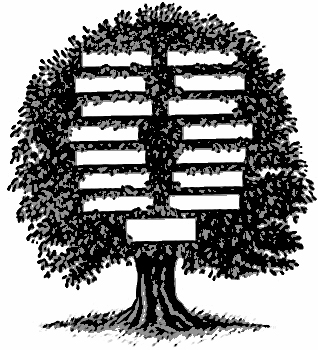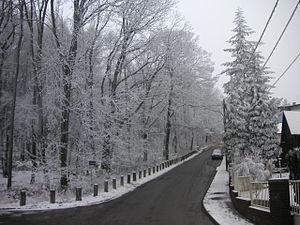
I can barely focus today. There’s a very good chance that both the son and grandson of Ezriel Kornmehl, the first subject of this family history writing challenge, have been located. If the information turns out to be correct, Ezriel’s son just celebrated his 90th birthday in Chicago, while his grandson is living and working in New York. Both are doctors, like their father/grandfather.
But I need to wait for confirmation of these branches to the family tree.
In the meantime, I’ll pass along a vignette about the subject of this part of the challenge, Viktor Kornmehl, along with his brother Bertschi (Berthold). Their memorial to their mother Kamilla involves real trees — and Palestine, making it relevant to the narrative of Austrian antisemitism and escape that I introduced yesterday.
If a Memorial Tree Falls in the Forest…
In the February 1930 issue of Die Stimme, a weekly Austrian Zionist newspaper, there was a notice for a long list of people buying trees for something called “Chajes-Wald.” Here’s the snippet of the list that includes Viktor and Berthold, indicating that their purchase was for the 10th anniversary of the death of their mother Kamilla Kornmehl:
Wald means woods or forest. The Vienna Woods, or Wienerwald, are famous. But what was “Chajes”? And where were the trees planted?

A search for Chajes led to Vienna’s chief Rabbi, Zvi Chajes. He was very involved with Zionist causes, as evidenced by this article that appeared in the Jewish Telegraphic Agency:
Dr. Zevi Chajes, Chief Rabbi of Vienna and member of the World Zionist Executive, arrived in New York on the “Leviathan” Tuesday. He was greeted at the pier by prominent American Zionist leaders.
Dr. Chajes, who intends to settle permanently in Palestine, will spend a short time in America.
He was there, in part, in the interests of the Juedischen Schulvereine (Jewish School Clubs) of Austria.
“The situation of Jewry in the Central European countries is worse than ever since the conclusion of the World War”, Dr. Chajes declared. “The hopelessness of the general economic situation in Central Europe has had a very bad effect upon the Jewish cultural life. Those who have been fighting for better national life in Austria have lost courage. This has affected the activities of the Zionist Organization in Austria and the maintenance of the Hebrew school system.”
Perhaps the most unusual thing about the article to me was the date: December 4, 1924. That’s more than a dozen years before the 1938 Anschluss.
Rabbi Chajes had planned to settle in Palestine but never made it. He died in 1927 of a heart attack, at the age of 51.
According to another JTA story, this one published January 12, 1928:
The memory of the late Dr. Zevi H. Chajes will be honored by the Austrian Zionist Organization which is raising a fund to plant 10,000 trees in Palestine. The plantation will be known as the Chajes Forest.
It makes sense that Viktor and Bertschi, both Zionists, would be planting a tree for an Austrian Zionist Rabbi in Israel.
What happened to the Chajes Forest, perhaps you wonder (or at least I did)?
To be continued…
This is Day 16 of the Family History Writing Challenge. I was going to stop writing here. I would have had more than enough words to fulfill the challenge goal. But it struck me that this challenge isn’t much of a challenge if it’s just about turning out X number of words rather than educating myself about my family’s history. So I kept researching and writing.
At least I had the sense to realize I could post the rest of the story tomorrow.

I found this interesting…
“The situation of Jewry in the Central European countries is worse than ever since the conclusion of the World War”, Dr. Chajes declared. “The hopelessness of the general economic situation in Central Europe has had a very bad effect upon the Jewish cultural life…
the current economy circumstances are now being manipulated by some whose relatives were involved in nazi Germany… as if they have a plan / road map of what works it would seem that their goal/ mission is to discriminate and create another barbaric holocaust… 8 million people in nazi Germany who were sent to con. camps were not Jewish but gay, black, disabled, Socialists, etc. plus 6 million Jews. jus saying…
I’m not sure what you mean — but it sounds scary! Who is doing the manipulating?
It’s amazing how a tiny, dry snippet–and a cryptic one, too–in a long-ago newspaper can open up into a human story once you get hold of a few connecting facts. And this one item also tells us so much about the people involved–that Viktor and Berthold were conscientious, good sons, Zionists, public-spirited, able to act together in a good deed, were on good terms, came from a strong family, etc. etc. And it’s great the way you expand upon it so that, yes, we do indeed learn more about history (from the inside, in a very personal way). What the Chief Rabbi (did I almost say Pope?) said about Jewish schools and culture was very revealing, also, for 1924, as you say. History is always more complicated than it appears at first.
I hadn’t thought about the relationship between the brothers and to their mother but I suspect you’re right. Of course, it’s possible they were competitive and had to go in together so one wouldn’t outshine the other and that they didn’t like their stepmother so they were showing her up by doing a public deed for their dead mother. (I don’t really think that — I’ve gotten fond of the two, somehow — but it’s not out of the question…)
I do enjoy these journeys, even if I’m a little pressed for time. And as you’ll see tomorrow, it all circles back to my childhood.
yes, the newspaper clipping. It’s such an unfolding from a tiny word – “Chajes-Wald”.
It’s a story told in a few words.
love the photos you’re coming up with!
That’s the way a forest should look!
The photos are always the hardest — what would I do without Wikimedia Commons? Without giving too much away, I’ll be curious to know if your experience with tree-planting in Israel, discussed tomorrow, is similar to mine.